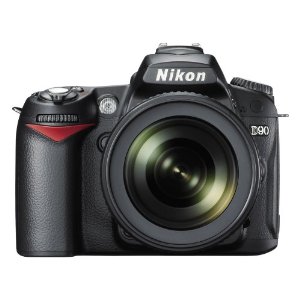A few years in the digital photography market can seem like an eternity, considering the quick advancements in technology and how willing the major camera manufacturers are to replace a successful model with an upgrade. That is what the Nikon D90 DSLR camera was to its predecessors, the D80, during 2008, and now the newer D5100 to the D90 during 2011. Despite the advancement to the D5100, Nikon’s D90 is still targeted at all enthusiasts and hobbyists, from “beginner” DSLR users to those with DSLR experience that don’t want to spend the bucks for semi-pro or pro cameras.


Read real customer reviews of the Nikon D90 here.
At the time of its release, Nikon gave the D90 a better CMOS sensor (12.3 megapixels); the 3.0-inch VGA screen and 3D tracking auto-focus (AF) from the D3/D300; Live View, contrast-detect AF; and the world’s first DSLR movie mode (720p HDTV quality) and HDMI output. All these features and capabilities are still quite comparable with cameras at the same price point, making the D90 a good choice, but for a narrower range of buyers than originally. Those just entering the world of DSLR photography may find the Nikon D90 an easier first step than newer models and all their additional bells and whistles.
Nikon didn’t radically change the body design of the D90; except it adopted some styling from the even earlier D70/D70s. Nikon knows how to make above-average plastic bodies and the D90 is firm and substantial. It’s also carefully and closely fitted to a well-manufactured metal framework. Rubber grips are strategically placed for the hand and thumb, giving photographers a reliable grasp of the camera. The D90’s improvements compared to the D80 include:
- 12.3-MP CMOS sensor (D80: 10.2 MP CCD).
- Dust removal system.
- 3.0-inch, 920,000 pixel (VGA x 3 colors) TFT-LCD (same as D3 and D300).
- Live View with contrast-detect AF.
- Movie Mode.
- Wider ISO range, upgraded AF system (3D tracking, face detection).
- Active D-Lighting, vignetting control and extra retouching options.
- Automatic chromatic aberration correction.
- Picture control presets.
- Faster continuous shooting and larger buffer (4.5 frames per second; buffer: 7 RAW, 25 JPEG fine, 100 JPEG Normal).
- Pictmotion slideshows.
Movie Mode
The Nikon D90’s video capability was the big news when it was introduced, being the first DSLR with a movie mode. Although its 720p HD (1280 x 720) spec is surpassed by more expensive cameras’ 1080p or 1080i, the D90’s video remains competitive with many cameras in its price range. Again, many beginners moving from a compact to a DSLR will find the D90’s move mode superior to their older point-and-shoot and, of course, provide a better set of features for shooing still pictures.
There are limitations to the D90’s movie mode, however. You must choose the aperture setting prior to going to Live View and auto-focus only works before you start recording, which means you must focus manually when shooting video. You will capture very good video, even in low light, considering the Nikon D90 is actually a stills camera first and a video camera a distant second. The camera only records a mono soundtrack, using an internal microphone, with no external mic connection.
It wouldn’t be fair to conclude that the D90 is filled with “old” technology, although it is amazing how quickly many digital cameras’ features and functions become average. That being said, “average” is often more than what DSLR beginners need initially. The Nikon D90 still gives them plenty of capacity to take all the digital photos and video they’ll ever want, as they develop their DSLR skills; and at approximately $700 (body only) is a value purchase.
This blog post about Nikon D90 DSLR camera was first published on our website here https://www.photographytalk.com/photography-equipment-reviews/1496-digital-photography-equipment-reviewthe-nikon-d90-dslr-camera
This blog post about Nikon D90 DSLR camera was first published on our website here https://www.photographytalk.com/photography-equipment-reviews/1496-digital-photography-equipment-reviewthe-nikon-d90-dslr-camera